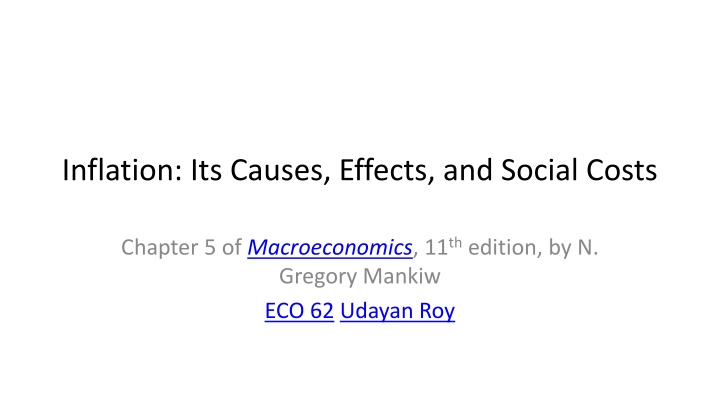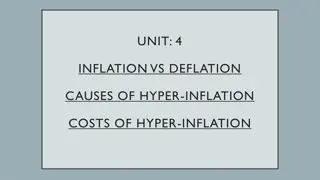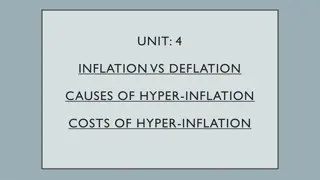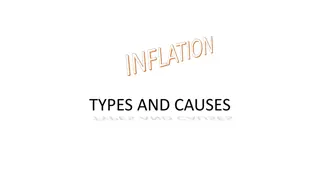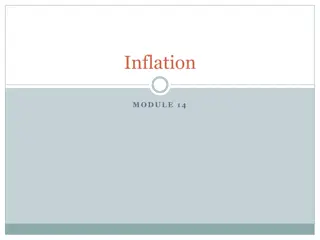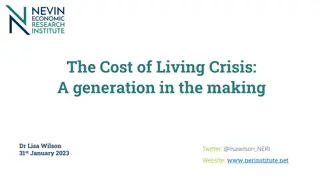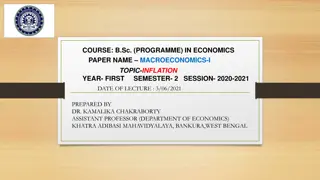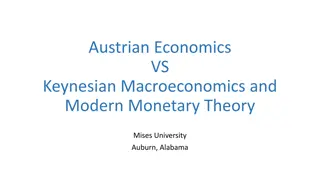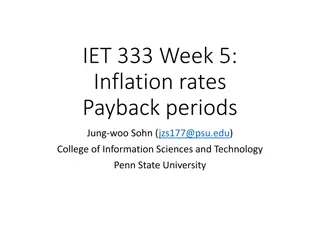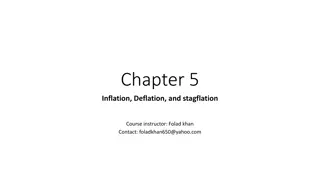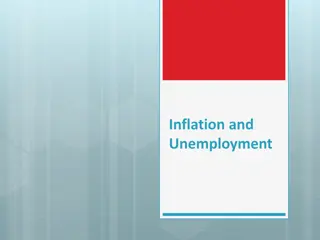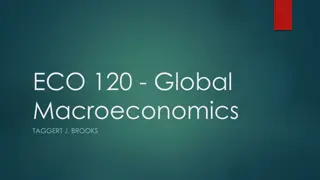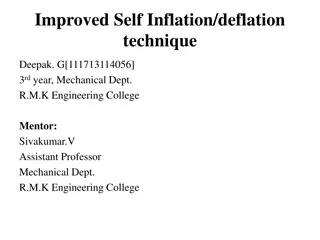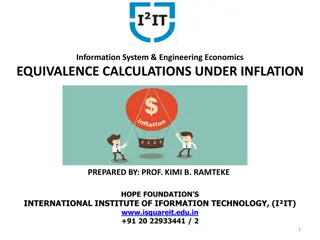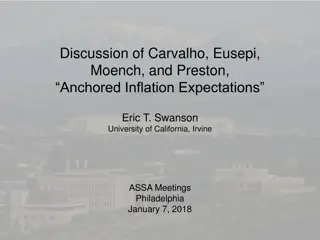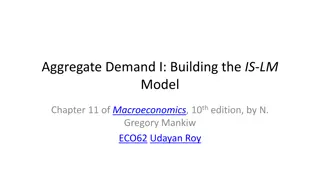Inflation: Causes, Effects, and Social Costs - Chapter 5 of Macroeconomics
Examining the causes, effects, and social costs of inflation, focusing on nominal variables and the quantity of money in the economy. Delve into monetary policy, the role of the central bank, money demand, and the control of the money supply in the long run.
Download Presentation

Please find below an Image/Link to download the presentation.
The content on the website is provided AS IS for your information and personal use only. It may not be sold, licensed, or shared on other websites without obtaining consent from the author.If you encounter any issues during the download, it is possible that the publisher has removed the file from their server.
You are allowed to download the files provided on this website for personal or commercial use, subject to the condition that they are used lawfully. All files are the property of their respective owners.
The content on the website is provided AS IS for your information and personal use only. It may not be sold, licensed, or shared on other websites without obtaining consent from the author.
E N D
Presentation Transcript
Inflation: Its Causes, Effects, and Social Costs Chapter 5 of Macroeconomics, 11thedition, by N. Gregory Mankiw ECO 62 Udayan Roy
Nominal Variables In Ch. 3 we saw a long-run theory of several real variables (Y, C, S, I, and r) Real variables are inflation-adjusted variables In this chapter we will see a long-run theory of three nominal variables: The overall price level, P The rate of inflation, The nominal interest rate, i I will be discussing only sections 5-1 (only Case Study: Inflation and Money Growth), 5-3 and 5-4.
Nominal Variables and the Quantity of Money We ll see that all of our three nominal variables are, in the long run, driven primarily by the quantity of money in the economy Recall that in Chapter 4 we discussed money, the quantity of money, and the control of the quantity of money by a country s central bank
The money supply and monetary policy definitions The quantity of money available in the economy (M) is also called the money supply Monetary policy is the control of the money supply. The growth rate of the money supply is denoted Mg. Both M and Mg are assumed exogenous
The Central Bank Monetary policy is conducted by a country s central bank. In the U.S., the central bank is called the Federal Reserve ( the Fed ). The Federal Reserve Building Washington, DC
Money Demand = Money Supply Although a country s central bank can control the money supply, ultimately the people must want to hold the money that the central bank wants them to hold That is, the desired money demand of the people must be equal to the desired money supply of the central bank How by what mechanism does thedesired money demand of the people become equal to the desired money supply of the central bank? We need to discuss money demand
We studied this in Chapter 3 RECAP: INTEREST RATES
The Real Interest Rate Imagine that lending and borrowing take place in our economy, but in commodities, not cash That is, you may borrow some amount of the final good, as long as you pay back the quantity you borrowed plus a little bit extra as interest The real interest rate (r) is the fraction of every unit of the final good borrowed that the borrower will have to pay to the lender as interest
The Nominal Interest Rate On the other hand, the interest paid for cash loans is called the nominal interest rate (i) It is the fraction of every dollar borrowed that the lender must pay in interest The nominal interest rate is not adjusted for inflation
The Nominal Interest Rate: Example Suppose you borrow $100 today and promise to pay back $110 a year from today Here i = 0.10 or 10 percent If prices are low a year from today, the purchasing power of the $10 you pay in interest will be high. So, you will regret the loss. If prices are high a year from today, the purchasing power of the $10 you pay in interest will be low. You will not regret the loss as much.
The Real Interest Rate In the case of cash loans, the real interest rate is the inflation- adjusted interest rate To adjust the nominal interest rate for inflation, you simply subtract the inflation rate from the nominal interest rate If the bank charges you 5% interest rate on a cash loan, that s the nominal interest rate (i = 0.05). If the inflation rate turns out to be 3% during the loan period ( = 0.03), then you paid the real interest rate of just 2% (r = i = 0.02)
The Real Interest Rate The problem is that when you are taking out a loan you don t quite know what the inflation rate will be over the loan period So, economists distinguish between the ex post real interest rate: r = i and the ex ante real interest rate: r = i E , where E is the expected inflation rate over the loan period
S = Y C(Y-T) G The Real Interest Rate r S = F(K, L) C(F(K, L) -T) G In Chapter 3, we also worked out the long- run theory of the (ex ante) real interest rate The theory yielded several predictions I(r)= Io Irr I Predictions Grid Y C S, I r K, L, A + + + Taxes, T 0 + C-shock, Co Govt purchases, G 0 + + 0 0 + I-shock, Io 0 0 0 +
Money demand and the interest rate We can keep our wealth (our assets) in two forms: Liquid (money = currency + demand deposits) Illiquid (stocks, bonds, real estate, a wine collection, etc.) Our demand for money depends on whether money is as good a store of value as the illiquid assets
Money demand and the interest rate Liquid assets are assumed to earn no interest Illiquid assets are assumed to earn the nominal interest rate i Therefore, an increase in i is assumed to reduce the demand for money Assumption: the quantity of money demanded (Md) is inversely related to the nominal interest rate (i)
Money demand and economic activity We also hold some of our wealth in the form of money instead of some illiquid asset because money is an excellent medium of exchange, excellent for shopping Therefore, the greater the need for shopping, the stronger will be the demand for money and the need for shopping can be measured by nominal GDP Assumption: the quantity of money demanded is directly related to nominal GDP
Money demand and economic activity Let P represent the overall level of prices, as measured by the GDP Deflator (Ch. 2) Recall that GDP Deflator =Nominal GDP Real GDP So, GDP Deflator Real GDP = Nominal GDP So, ? ? = Nominal GDP Assumption: the quantity of money demanded (Md) is directly related to nominal GDP (P Y)
Money Demand So, Md is inversely related to i, and directly related to P Y ??= ?(?) ? ? Here, L, is the desire for liquidity. It is inversely related to i, the nominal interest rate.
Money Demand = Money Supply For equilibrium in the money market we need the demand for money to be equal to the supply of money ??= ? ? ? ? = ?
Money Demand = Money Supply ? ? ? ? = ? We saw in Chapter 2 that the growth rate of a product of several variables is the sum of the growth rates of those variables. Therefore, denoting growth rates by the g subscript, we get ??+ ??+ ??= ??
Inflation ??+ ??+ ??= ?? Recall that the rate of inflation ( ) is simply the growth rate of the overall level of prices (Pg): that is, = Pg Therefore, the equation above becomes ??+ ? + ??= ?? Therefore, = Mg Lg Yg
Growth Rates of Money and Output Assumption: The growth rates of the quantity of money (Mg) and real GDP (Yg) are both exogenous
Nominal Interest Rate: Simplifying assumption I ll make the following assumption to simplify our analysis Assumption: In the long run, the nominal interest rate (i) stays constant over time As a result, L(i) also stays constant over time Therefore, its growth rate must be zero: Lg = 0
Nominal Interest Rate: Simplifying assumption As Lg = 0, the equation = Mg Lg Yg we saw a few slides back becomes = Mg Yg. As both Mg and Yg are assumed exogenous, we now have a solution for inflation ( )! Our long-run theory of inflation is complete
Inflation in the Long Run = Mg Yg In the long run, the inflation rate is equal to the rate at which the money supply grows minus the rate at which real GDP grows Example: if real GDP grows at the annual rate of 3.5% and if the quantity of money grows at the annual rate of 4%, then the rate of inflation will be 0.5% Inflation occurs when too much money chases too few goods
Inflation in the Long Run Long-Run Predictions Grid (Ch. 3) Y C S, I r Recall that one exogenous variable cannot, by definition, affect another exogenous variable So, changes in K, L, A, T, Co, G, and Io cannot affect inflation = Mg Yg. And Mg Yg obviously has a direct effect on inflation because = Mg Yg. K, L, Technology (A) + + + Taxes, T 0 + C-shock, Co Govt, G 0 + + 0 0 + I-shock, Io 0 0 0 + Long-Run Predictions Grid Y C S, I r K, L, A + + + 0 T 0 + 0 Co G 0 + + 0 0 0 + 0 Io Mg Yg 0 0 0 + 0 0 0 0 0 +
Expected Inflation: Simplifying Assumption Assumption: In the long run, expected inflation equals actual inflation (E = ) Recall that ? = ? ?? Therefore, ? = ? + ?? = ? + ? = ? + ?? ??
Nominal Interest Rate in the Long Run We just saw that ? = ? + ?? ?? As we already have a theory of r from Chapter 3, and as both Mg and Yg are exogenous, we now have a theory of the nominal interest rate (i) as well
Nominal Interest Rate in the Long Run ? = ? + ?? ?? Recall that changes in K, L, A, T, Co, G, and Io cannot affect inflation = Mg Yg. So their effect on i must be the same as their effect on r. And, as Mg Yg has zero effect on r, any change in = Mg Yg must cause an identical change in i. This is called the Fisher Effect Long-Run Predictions Grid Y C S, I r , E i K, L, A + + + 0 T 0 + 0 C-shock, Co G 0 + + 0 + 0 0 + 0 + I-shock, Io Mg Yg 0 0 0 + 0 + 0 0 0 0 + +
Nominal Interest Rate in the Long Run ? = ? + ?? ?? Long-Run Predictions Grid Y C S, I r , E i K, L, A + + + 0 T 0 + 0 C-shock, Co G 0 + + 0 + Q: Can you see why the equation above yields the predictions in the i- column? 0 0 + 0 + I-shock, Io Mg Yg 0 0 0 + 0 + 0 0 0 0 + + Next, the price level, P
The Overall Price Level in the Long Run ? Recall that ? ? ? ? = ? which implies ?(?) ?= ? As we have already developed theories of the nominal interest rate (i) and real GDP (Y), and as the quantity of money (M) is exogenous, the above equation gives our theory of the overall price level (P) We now have long-run theories for all three of our nominal variables ( , i, and P)!
The Overall Price Level in the Long Run Let s be more specific about L(i), which is the desire for liquidity We have seen that the desire for liquidity is inversely related to the nominal interest rate So, let ? ? =?0 ? Here, L0 is the liquidity shock. It represents all factors other than P, Y, and ithat affect people s demand for money. L0 represents wealth and the distrust of non-cash assets.
The Overall Price Level in the Long Run ? ? ? ? ?0 ? Then ? = ?(?) ?= (?0/?) ?= Long-Run Predictions Grid (so far) Long-Run Predictions Grid Y C S, I r , E i Y C S, I r , E i P K, L, A + + + 0 K, L, A + + + 0 T 0 + 0 T 0 + 0 C-shock, Co G 0 + + 0 + C-shock, Co G 0 + + 0 + + 0 0 + 0 + 0 0 + 0 + + I-shock, Io Mg Yg 0 0 0 + 0 + I-shock, Io Mg Yg M 0 0 0 + 0 + + 0 0 0 0 + + 0 0 0 0 + + + 0 0 0 0 0 0 + L-shock, L0 0 0 0 0 0 0
Static Long-Run Macroeconomics in one slide! ? = ? ?0.3?0.7 ? = ?0+ ?? (? ?) ? = ? = ? ? ? ? = ?0 ?? ? which gives ? =?0 ? Long-Run Predictions Grid Y C S, I r , E i P K, L, A + + + 0 T 0 + 0 C-shock, Co G 0 + + 0 + + 0 0 + 0 + + ?? I-shock, Io Mg Yg M 0 0 0 + 0 + + 0 0 0 0 + + + ? = ?? ?? ? = ? + ? ? =?0 0 0 0 0 0 0 + L-shock, L0 0 0 0 0 0 0 ? ? ?0 ? ? ? ? which gives ? = Variables in red font are endogenous. Variables in black font are exogenous.
Long-Run Macroeconomics (Static) Note that the money supply and its growth rate have no effect on the real endogenous variables This result is called monetary neutrality It holds in long-run theory, but not in short-run theory Long-Run Predictions Grid Y C S, I r , E i P K, L, A + + + 0 T 0 + 0 C-shock, Co G 0 + + 0 + + 0 0 + 0 + + I-shock, Io Mg Yg M 0 0 0 + 0 + + 0 0 0 0 + + + 0 0 0 0 0 0 + L-shock, L0 0 0 0 0 0 0
Long-Run Macroeconomics (Static) Recall that i = r + E = r + , assuming expected inflation = actual inflation This yields the Fisher Effect: whatever affects inflation also has an identical effect on the nominal interest rate Long-Run Predictions Grid Y C S, I r , E i P K, L, A + + + 0 T 0 + 0 C-shock, Co G 0 + + 0 + + 0 0 + 0 + + I-shock, Io Mg Yg M 0 0 0 + 0 + + 0 0 0 0 + + + 0 0 0 0 0 0 + L-shock, L0 0 0 0 0 0 0
Long-Run Macroeconomics (Static) Exercise: Fill the blanks with + (same direction effect), (opposite direction effect), 0 (no effect), or ? (uncertain effect). Long-Run Predictions Grid Y C S, I r , E i P K, L, A T C-shock, Co G I-shock, Io Mg Yg M L-shock, L0
Figure 5 2: International Data on Inflation and Money Growth
